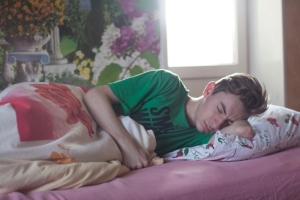Quality of Sleep in Children Influences Alcohol and Marijuana Use in Adolescence
Sleep deprivation in childhood can harm the neurological development of a child's brain (1).
Sleep is an essential biological process at all stages of life. During childhood, a significant amount of time is dedicated to sleep, which is crucial for proper physical development, strengthening the body's natural defenses against illness, and promoting overall quality of life and well-being (2). According to the Brazilian Sleep Association (BSA), good sleep is important at any age as it positively affects daily behavior, increasing concentration, memory, and learning abilities.
The pattern and amount of sleep needed vary according to the child's age. According to the BSA, infants aged 4 to 12 months need 12 to 16 hours of sleep per day. Children aged 1 to 2 years should sleep between 11 and 14 hours, while those aged 3 to 5 require 10 to 13 hours of sleep. For children aged 6 to 12 years, the recommendation is to sleep 9 to 12 hours per night. Unfortunately, sleep insufficiency is prevalent among children and adolescents, and the consequences are related to reduced development of the prefrontal cortex, which can impair decision-making skills (3,4,5).
One study showed that sleep loss in children is also associated with increased activation of the brain's reward centers, disproportionately increasing motivation for unhealthy behaviors, such as alcohol and marijuana use (6). Adolescent alcohol use has been linked to deficits in executive function, visuospatial function, short- and long-term memory, and working memory—consequences that can have significant implications for future life.
Although there is a lack of studies comparing the effects of childhood sleep at different developmental stages within the same sample of children, a recent study analyzed how sleep during weekdays in childhood can influence substance use in adolescence (7). The results showed that children who go to bed later during the week are more likely to use substances by age 15, while shorter sleep duration in late childhood was specifically associated with an increased risk of marijuana use in adolescence.
In light of this, it is essential to promote healthy sleep habits from childhood to prevent negative consequences in adolescence, including alcohol use, other psychoactive substances, and cognitive difficulties. Investing in education about the importance of sleep and creating appropriate routines can help ensure the healthy development of children, reducing the risks of future problems associated with insufficient sleep.
References:
- Atrooz, F., & Salim, S. (2020). Sleep deprivation, oxidative stress and inflammation. Advances in protein chemistry and structural biology, 119, 309–336. https://doi.org/10.1016/bs.apcsb.2019.03.001
- Ramar, K., Malhotra, R. K., Carden, K. A., Martin, J. L., Abbasi-Feinberg, F., Aurora, R. N., Kapur, V. K., Olson, E. J., Rosen, C. L., Rowley, J. A., Shelgikar, A. V., & Trotti, L. M. (2021). Sleep is essential to health: an American Academy of Sleep Medicine position statement. Journal of clinical sleep medicine: JCSM : official publication of the American Academy of Sleep Medicine, 17(10), 2115–2119. https://doi.org/10.5664/jcsm.9476
- Wheaton, A. G., Jones, S. E., Cooper, A. C., & Croft, J. B. (2018). Short Sleep Duration Among Middle School and High School Students - United States, 2015. MMWR. Morbidity and mortality weekly report, 67(3), 85–90. https://doi.org/10.15585/mmwr.mm6703a1
- Curcio, G., Ferrara, M., & De Gennaro, L. (2006). Sleep loss, learning capacity and academic performance. Sleep medicine reviews, 10(5), 323–337. https://doi.org/10.1016/j.smrv.2005.11.001
- Euston, D. R., Gruber, A. J., & McNaughton, B. L. (2012). The role of medial prefrontal cortex in memory and decision making. Neuron, 76(6), 1057–1070. https://doi.org/10.1016/j.neuron.2012.12.002
- McDonald, L., Wardle, J., Llewellyn, C. H., & Fisher, A. (2015). Nighttime sleep duration and hedonic eating in childhood. International journal of obesity (2005), 39(10), 1463–1466. https://doi.org/10.1038/ijo.2015.132
- Krishnan, A. S., Reichenberger, D. A., Strayer, S. M., Master, L., Russell, M. A., Buxton, O. M., Hale, L., & Chang, A. M. (2024). Childhood sleep is prospectively associated with adolescent alcohol and marijuana use. Annals of epidemiology, 98, 25–31. https://doi.org/10.1016/j.annepidem.2024.07.048


